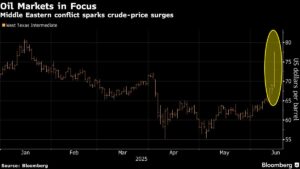Geopolitical Unrest Drives Oil Prices Higher: What Investors Should Know
In the wake of escalating military exchanges between Israel and Iran, the oil market is reacting significantly. Investors have seen Brent crude prices spike by as much as 5.5% during early Asian trading hours as tensions rise—a clear indicator of how geopolitical frictions can sway global markets.
Current Situation: A Competitive Battlefield
This latest uptick in oil prices comes after a series of aggressive actions over the weekend, including Israel’s strike on Iran’s South Pars gas field in the Persian Gulf. This facility is crucial for energy production, and its targeting has caused production platform shutdowns—raising serious alarms about the potential for prolonged disruptions in this vital oil-producing region.
Last week saw crude oil prices soar over 7% amid fears that the ongoing conflict could escalate further, affecting the very lifeblood of the global economy. The uncertainty isn’t limited to oil; traditional safe havens such as gold and the U.S. dollar have also seen gains, though U.S. Treasury yields are under pressure due to persistent inflation concerns.
Market commentators, like Wolf von Rotberg from Bank J. Safra Sarasin, advise caution; he notes, “Markets should be prepared for a prolonged period of uncertainty.” For investors, hedging against potential oil supply disruptions while adding to gold reserves may provide a buffer against further turmoil in the Middle East.
Broader Implications for Global Markets
The conflict’s intensity has extended its shadow over risk assets, with the MSCI World Index witnessing its most significant drop since April in response to Israel’s initial strikes. Equity strategist Michael O’Rourke from JonesTrading opines that the severity of the situation signals a deeper conflict that may have longer-lasting ramifications for financial markets.
As fear ripples across the market, many investors find themselves pausing, gauging the duration and impact of the current tensions. Unlike past conflicts that frequently de-escalated, the present hostilities show signs of being more profound—impacting everything from stock indices to energy prices.
Regional Market Responses and Outlook
Mixed reactions are observed within regional stock indices. Egypt’s index experienced significant declines, revealing concerns about potential fuel shortages stemming from halted Israeli gas production. Conversely, the Saudi Tadawul gauge only saw limited declines, primarily buoyed by gains in Aramco due to rising oil prices.
Traders are increasingly grappling with not only these geopolitical tensions but also the shifting landscape of global trade relationships, economic fluctuations, and the ongoing ramifications from other geopolitical events like the conflict between Russia and Ukraine.
Dave Mazza from Roundhill Investments points out, “Unless oil prices remain high and inflations correspondingly rise, what we are witnessing might be a pause rather than a panic.” He suggests that this could present a buying opportunity, though any further gains may be hard-fought given the recent rally from market lows.
Key Market Movements
In today’s trading environment:
-
Stock Futures: S&P 500 futures are stable, while Asian indices have shown mixed results with Hang Seng futures down 0.5% and S&P/ASX 200 futures falling 0.2%.
-
Currency Performance: The Bloomberg Dollar Spot Index remains relatively unchanged, with the euro and the Japanese yen showing minimal fluctuations against the dollar.
-
Cryptocurrency Activity: Bitcoin has risen 0.5%, reaching approximately $105,248.83, and Ether saw a 1.6% increase to around $2,543.28.
- Commodity Prices: The West Texas Intermediate crude surged by 2.2% to hit $74.58 per barrel, while spot gold prices increased by 0.3%, now at $3,444.30 per ounce.
Conclusion
As tensions continue to escalate in the Middle East, the ramifications on global financial markets are complex and multifaceted. Investors should remain vigilant, considering strategic moves that account for both geopolitical risks and economic indicators.
To make informed decisions, stay updated on market developments and consider diversifying your portfolio to mitigate risks associated with these unpredictable times. The current geopolitical climate presents challenges but also opportunities for those who navigate it wisely.

